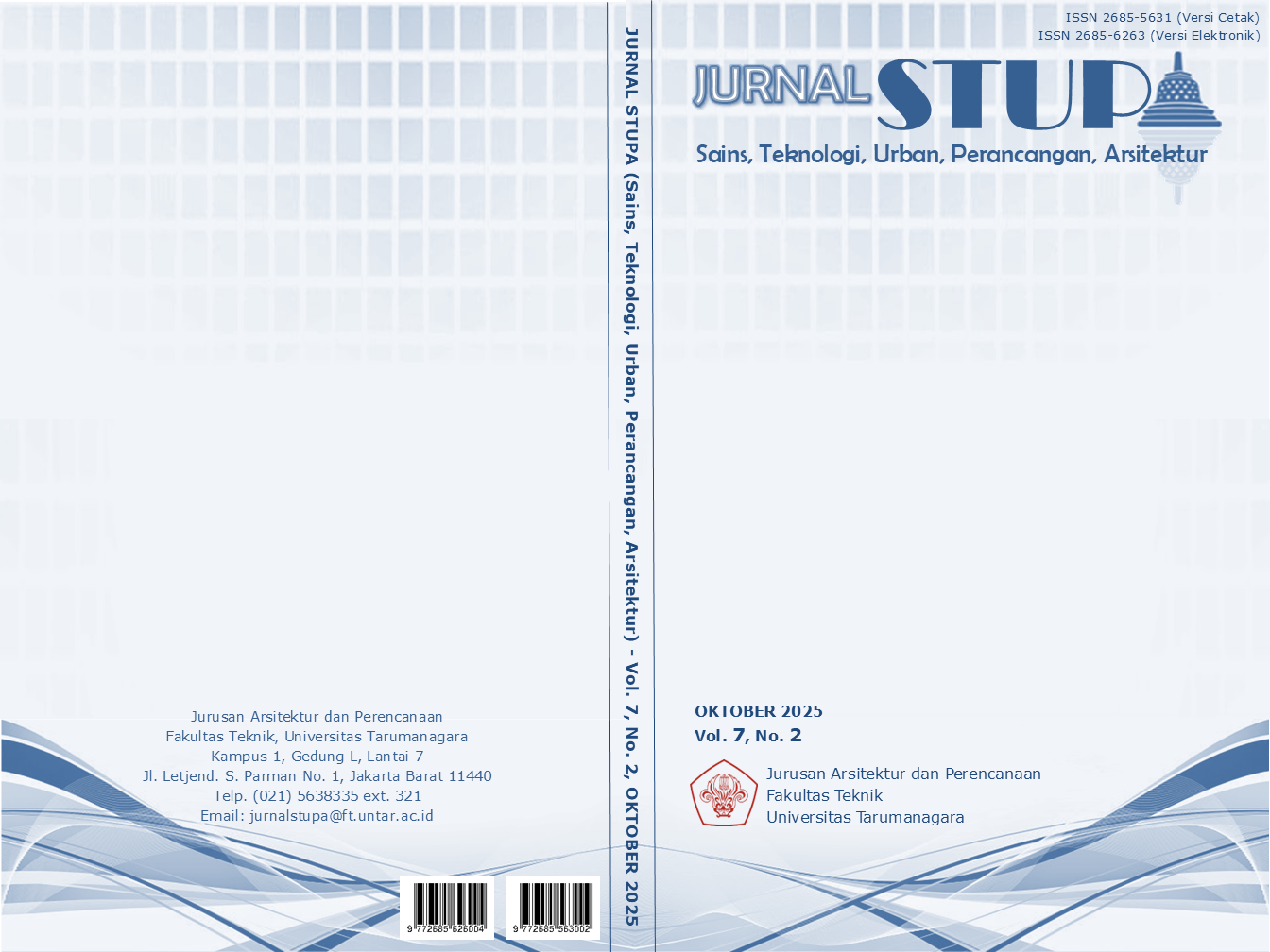PENERAPAN PENDEKATAN TIPOLOGI DAN URBANISME LANSKAP DALAM STRATEGI DESAIN REGENERATIF PEMAKAMAN PERKOTAAN DI TPU MENTENG PULO
Main Article Content
Abstract
Jakarta faces urban pressure from high population density and limited land availability, while inner-city cemeteries occupy large strategic areas that remain underutilized. Traditionally, public cemeteries (TPU) serve only as passive burial grounds, contradicting their designation as RTH-7, which requires them to function as green spaces, burial sites, social spaces, and sources of revenue. TPU Menteng Pulo exemplifies the complex interplay between land scarcity, burial needs, and untapped ecological potential. This research aims to develop a regenerative design strategy by integrating architectural typology and landscape urbanism principles. The methodology begins with a typological analysis of burial practices based on spatial orientation (horizontal/vertical), burial technology (in-ground, cremation, alternatives), and cultural values. These findings inform the creation of functional zones: Earth (traditional horizontal burial), Mountain (modular vertical structures), and Forest (active landscape). The landscape urbanism approach transforms passive land into multifunctional RTH-7, activating ecological (carbon absorption), social (communal space), and economic (income generation) functions while maintaining the primary burial role. Ultimately, this study offers an applicative framework for managing urban cemeteries in dense areas through a regenerative approach that balances technical, environmental, and socio-cultural aspects.
Keywords: burial typology; landscape urbanism; regenerative design; urban cemetery
Abstrak
Jakarta menghadapi tekanan urban akibat kepadatan penduduk dan keterbatasan lahan, sementara Tempat Pemakaman Umum (TPU) di pusat kota justru menempati area strategis yang luas namun tidak termanfaatkan secara optimal. Selama ini, TPU berfungsi secara pasif sebagai lahan penguburan horizontal tanpa kontribusi aktif terhadap kehidupan perkotaan, sehingga menjadi "lahan mati" dalam struktur kota. Hal ini bertentangan dengan peruntukkan lahan TPU sebagai RTH-7 yang mana selain hadir sebagai lahan hijau juga berfungsi sebagai lahan penguburan serta pendukung kota seperti berfungsi sebagai ruang sosial bagi masyarakat dan sebagai sumber pendapatan. Dengan ini, TPU Menteng Pulo merepresentasikan isu kompleks antara keterbatasan lahan, kebutuhan ruang pemakaman, dan potensi ekologis yang belum tergarap. Maka, penelitian ini bertujuan mengembangkan strategi desain regeneratif melalui integrasi pendekatan tipologi arsitektural dan prinsip urbanisme lanskap. Metode penelitian diawali dengan analisis tipologi pemakaman berbasis tiga kriteria: (1) orientasi spasial (horizontal/vertikal), (2) teknologi penguburan (tanah/kremasi/alternatif), dan (3) nilai kultural. Temuan tipologi kemudian diimplementasikan melalui pembagian zona fungsional: Earth (pemakaman horizontal tradisional), Mountain (struktur vertikal modular), dan Forest (lanskap aktif). Pendekatan urbanisme lanskap memungkinkan transformasi lahan pasif menjadi memenuhi fungsinya sebagai RTH-7 yang mengaktifkan tiga fungsi simultan: ekologis (penyerapan karbon), sosial (ruang komunal), dan ekonomi (sumber pendapatan) dan disaat yang bersamaan tetap mempertahankan fungsi utama sebagai lahan penguburan. Akhirnya, temuan ini memberikan kerangka aplikatif bagi pengelolaan TPU perkotaan di kawasan padat dengan pendekatan regeneratif yang seimbang antara aspek teknis, lingkungan, dan sosio-kultural.
Article Details

This work is licensed under a Creative Commons Attribution-NonCommercial-ShareAlike 4.0 International License.
This work is licensed under a Jurnal Sains, Teknologi, Urban, Perancangan, Arsitektur/ STUPA Creative Commons Attribution-NonCommercial-ShareAlike 4.0 International LicenseReferences
Assargård, H. (2011). Landscape Urbanism (from a methodological perspective and a conceptual framework). Master’s Thesis of Landscape Planning Department of Urban and Rural Development Swedish University of Agricultural Sciences.
Dwinurcahyo, G. A., & Winata, T. (2021, Oktober 23). PEMAKAMAN MASA DEPAN RAMAH LINGKUNGAN DI CISAUK. Jurnal STUPA: Sains, Teknologi, Urban, Perancangan, Arsitektur, 3(2), 1703 - 1712. 10.24912/stupa.v3i2.12451
Fatimah, N. (2021). Model Penataan Pemakaman sebagai Ruang Terbuka Hijau di Kota Makassar. Repository UNHAS. https://repository.unhas.ac.id/id/eprint/13466/2/P032191006_tesis_04-02-2022%20B ab1-2.pdf
Filifin, P., Astra, I. M., & Budiaman. (2023, April). ANALISIS KEBUTUHAN RUANG TERBUKA HIJAU DI JAKARTA. Al Qalam: Jurnal Ilmiah Keagamaan dan Kemasyarakatan, 17(2), 894-906. 10.35931/aq.v17i2.1966
Grabalov, P., & Nordh, H. (2021, November 15). The Future of Urban Cemeteries as Public Spaces: Insights from Oslo and Copenhagen. PLANNING THEORY & PRACTICE, 23(1), 81–98. https://doi.org/10.1080/14649357.2021.1993973
Indrianingrum, L., v, N., & Sari, S. R. (2023). Cemetery Kampung: Spatial Characteristics and Exploration of Identity. Journal of Urban Culture Research, 26, 245-267. https://www.cujucr.com/downloads/Individual%20Articles/26/vol%2026%20Lulut%20I ndrianingrum%20et%20al.pdf
Itescu, Y., & Jeschke, J. M. (2019, July). Assessing the conservation value of cemeteries to urban biota worldwide. Conservation Biology, 38(6). 10.1111/cobi.14322
Jang, J. (2021, Desember). Urban Cemeteries: Evolving Functions and Identities. Places Journal. https://placesjournal.org/workshop-article/urban-cemeteries-evolving-functions-and-i dentities/
Kee, S. H., & Baek, J. (2024, Januari). A Study on the Legal Types of Urban Cemeteries-Focusing on Approaches to Circumvent the Urban Cemetery Prohibition Provision in the Enforcement Decree of the Act On Funeral Services. Journal of the Architectural Institute of Korea, 40(1), 101-112. https://doi.org/10.5659/JAIK.2024.40.1.101
Kolnberger, T. (2018). Cemeteries and urban form: a historico-geographical approach. Identités. Politiques, Sociétés, Espaces (IPSE), 22(2), 119–139.
Lyle, J. T. (1994). Regenerative Design for Sustainable Development.
Mang, P., Reed, B., & Regenesis Group and Story of Place Institute. (2012, Januari). Regenerative Development and Design. Encyclopedia Sustainability Science & Technology, 2112(303). 10.1007/978-1-4419-0851-3_303
Nofitasari, S. A. U., & Supatra, S. (2022, Maret 28). PEMAKAMAN VERTIKAL SEBAGAI TIPOLOGI BARU. Jurnal STUPA: Sains, Teknologi, Urban, Perancangan, Arsitektur, 4(1), 283-296. 10.24912/stupa.v4i1.16895
Saumel, I., Buttenschon, S., & Kreibig, N. (2023, Januari 04). Gardens of life: Multifunctional and ecosystem services of urban cemeteries in Central Europe and beyond—Historical, structural, planning, nature and heritage conservation aspects. frontiers, 10. https://doi.org/10.3389/fenvs.2022.1077565



